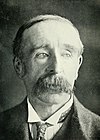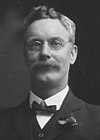
The Nationalist Party, also known as the National Party was an Australian political party. It was formed on 17 February 1917 from a merger between the Commonwealth Liberal Party and the National Labor Party, the latter formed by Prime Minister Billy Hughes and his supporters after the 1916 Labor Party split over World War I conscription. The Nationalist Party was in government until electoral defeat in 1929. From that time it was the main opposition to the Labor Party until it merged with pro-Joseph Lyons Labor defectors to form the United Australia Party (UAP) in 1931. The party is a direct ancestor of the Liberal Party of Australia, the main centre-right party in Australia.

William Morris Hughes,, was an Australian politician who served as the 7th Prime Minister of Australia, in office from 1915 to 1923. He is best known for leading the country during World War I, but his influence on national politics spanned several decades. Hughes was a member of federal parliament from Federation in 1901 until his death, the only person to have served for more than 50 years. He represented six political parties during his career, leading five, outlasting four, and being expelled from three.

Sir Joseph Cook, was an Australian politician who served as the sixth Prime Minister of Australia, in office from 1913 to 1914. He was the leader of the Liberal Party from 1913 to 1917, after earlier serving as the leader of the Anti-Socialist Party from 1908 to 1909.

Francis Gwynne Tudor was an Australian politician who served as the leader of the Australian Labor Party from 1916 until his death. He had previously been a government minister under Andrew Fisher and Billy Hughes.

Jens August Jensen was an Australian politician who served in the House of Representatives from 1910 to 1919. He was a minister in the governments of Andrew Fisher and Billy Hughes, serving as Minister for the Navy from 1915 to 1917 and Minister for Trade and Customs from 1917 to 1918.
The National Labor Party was formed by Australian Prime Minister Billy Hughes in 1916, following the 1916 Labor split on the issue of World War I conscription in Australia. Hughes had taken over as leader of the Australian Labor Party and Prime Minister of Australia when anti-conscriptionist Andrew Fisher resigned in 1915. He formed the new party for himself and his followers after he was expelled from the ALP a month after the 1916 plebiscite on conscription in Australia. Hughes held a pro-conscription stance in relation to World War I.

The Watson Ministry (Labour) was the 3rd ministry of the Government of Australia, and the first national Labour government formed in the world. It was led by the country's 3rd Prime Minister, Chris Watson. The Watson Ministry succeeded the First Deakin Ministry, which dissolved on 27 April 1904 after Labour withdrew their support and Alfred Deakin was forced to resign. The ministry was replaced by the Reid Ministry on 17 August 1904 after the Protectionist Party withdrew their support over the Conciliation and Arbitration Bill.
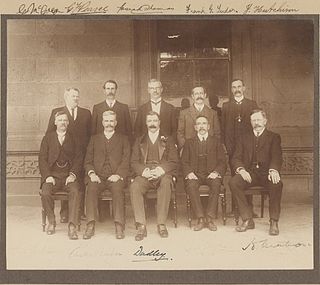
The First Fisher Ministry (Labour) was the 6th ministry of the Government of Australia. It was led by the country's 5th Prime Minister, Andrew Fisher. The First Fisher Ministry succeeded the Second Deakin Ministry, which dissolved on 13 November 1908 after Labour withdrew their support and Alfred Deakin was forced to resign. The ministry was replaced by the Third Deakin Ministry on 2 June 1909 after the Protectionist Party and the Anti-Socialist Party merged into the Commonwealth Liberal Party "fusion" and withdrew their support in order to form what became the first majority government in federal Australian history.

The Third Fisher Ministry (Labor) was the 10th ministry of the Government of Australia. It was led by the country's 5th Prime Minister, Andrew Fisher. The Third Fisher Ministry succeeded the Cook Ministry, which dissolved on 17 September 1914 following the federal election that took place on 5 September which saw Labor defeat Joseph Cook's Commonwealth Liberals. The ministry was replaced by the First Hughes Ministry on 27 October 1915 following Fisher's retirement from Parliament to become the next High Commissioner to the United Kingdom.

The Second Hughes Ministry was the 12th ministry of the Government of Australia. It was led by the country's 7th Prime Minister, Billy Hughes. The Second Hughes Ministry succeeded the First Hughes Ministry, which dissolved on 14 November 1916 following the split that took place within the governing Labor Party over the issue of conscription. This led to Hughes and his supporters leaving the party to form the National Labor Party, which swiftly received parliamentary support from Joseph Cook and the Commonwealth Liberal Party. The ministry was replaced by the Third Hughes Ministry on 17 February 1917 after National Labor and Commonwealth Liberal merged into the Nationalist Party.

The Fourth Hughes Ministry (Nationalist) was the 14th ministry of the Government of Australia. It was led by the country's 7th Prime Minister, Billy Hughes. The Fourth Hughes Ministry succeeded the Third Hughes Ministry, which dissolved on 8 January 1918 following the resignation of Hughes as Prime Minister after a vote of no-confidence within the Nationalist Party in the wake of a failed second referendum on conscription. However, due to a lack of alternative leaders, Hughes was immediately re-commissioned as Prime Minister by Governor-General Sir Ronald Munro Ferguson. The ministry was replaced by the Fifth Hughes Ministry on 3 February 1920 following the 1919 federal election.

The Fifth Hughes Ministry (Nationalist) was the 15th ministry of the Government of Australia. It was led by the country's 7th Prime Minister, Billy Hughes. The Fourth Hughes Ministry succeeded the Fourth Hughes Ministry, which dissolved on 3 February 1920 following the federal election that took place in December. The ministry was replaced by the First Bruce Ministry on 9 February 1923 following the 1922 federal election and the subsequent resignation of Hughes as Prime Minister.

The First Bruce Ministry was the 16th ministry of the Government of Australia. It was led by the country's 8th Prime Minister, Stanley Bruce. The First Bruce Ministry succeeded the Fifth Hughes Ministry, which dissolved on 9 February 1923 following the December 1922 federal election and the subsequent resignation of Billy Hughes as Prime Minister. The Nationalists had lost their majority in the election, and had no choice but to negotiate a Coalition deal with the Country Party. However, Country leader Earle Page let it be known that no deal could be made unless Hughes resigned. It is the first ministry that consists of a centre-right Coalition between the senior conservative party and the junior rural party - this Coalition has more or less endured to this day with the modern-day Liberal Party and National Party. The ministry was replaced by the Second Bruce Ministry on 18 December 1925 following the 1925 federal election.
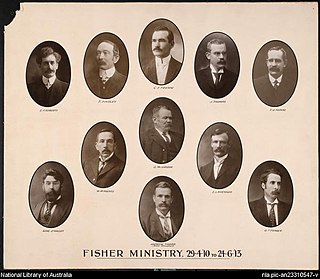
The Second Fisher Ministry was the 8th ministry of the Government of Australia. It was led by the country's 5th Prime Minister, Andrew Fisher. The Second Fisher Ministry succeeded the Third Deakin Ministry, which dissolved on 29 April 1910 following the federal election that took place on 13 April which saw Labor defeat the Alfred Deakin's Commonwealth Liberal Party. It is the first federal government in Australian history to be elected with a majority in the House of Representatives, as well as the first majority national Labor government in the world. The ministry was replaced by the Cook Ministry on 24 June 1913 following the federal election that took place in May which saw the Liberals defeat Labor.
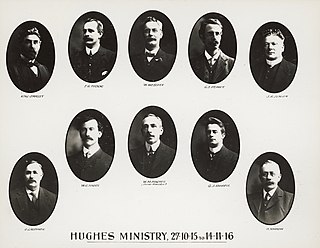
The First Hughes Ministry (Labor) was the 12th ministry of the Government of Australia. It was led by the country's 7th Prime Minister, Billy Hughes. The First Hughes Ministry succeeded the Third Fisher Ministry, which dissolved on 27 October 1915 following Andrew Fisher's retirement from Parliament to become the next High Commissioner to the United Kingdom. The ministry was replaced by the Second Hughes Ministry on 14 November 1916 following the split that took place within Labor over the issue of conscription. This led to Hughes and his supporters leaving the party to form the National Labor Party.

Sir George Foster Pearce KCVO was an Australian politician who served as a Senator for Western Australia from 1901 to 1938. He began his career in the Labor Party but later joined the National Labor Party, the Nationalist Party, and the United Australia Party; he served as a cabinet minister under prime ministers from all four parties.

William Oliver Archibald was an Australian politician. He was a member of the South Australian House of Assembly from 1893 to 1910, representing Port Adelaide, and a member of the Australian House of Representatives from 1910 to 1919, representing Hindmarsh. Archibald was a Labor member until resigning in the 1916 Labor split; he subsequently served as a Nationalist until his defeat at the 1919 federal election.

The 1917 Australian federal election was held in Australia on 5 May 1917. All 75 seats in the House of Representatives and 18 of the 36 seats in the Senate were up for election. The incumbent Nationalist Party, led by Prime Minister Billy Hughes, defeated the opposition Labor Party led by Frank Tudor in a landslide.
This is a list of the members of the Australian House of Representatives in the Sixth Australian Parliament, which was elected at the 1914 election on 5 September 1914.
During the second half of World War I, the First Australian Imperial Force experienced a shortage of men as the number of men volunteering to fight overseas declined and the casualty rate increased. At the time, military service within the Commonwealth of Australia and its territories was compulsory for Australian men, but that requirement did not extend to conflict outside of Australia. In 1916, Prime Minister Billy Hughes called a plebiscite to determine public support for extending conscription to include military service outside the Commonwealth for the duration of the war. The referendum, held on 28 October 1916, narrowly rejected the proposal. A second plebiscite, held a year later on 20 December 1917, also failed to gain a majority.








